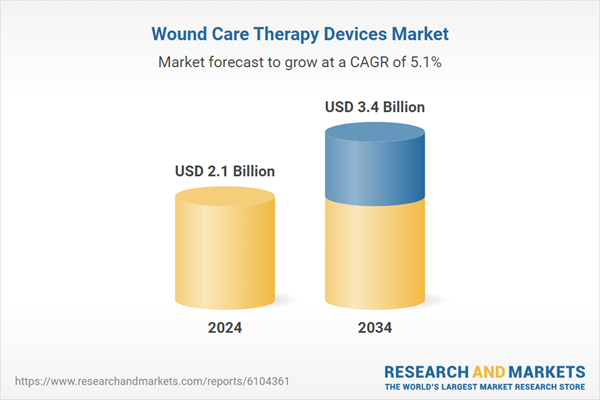The growing prevalence of chronic wounds, particularly among elderly populations, is a major driver of market expansion. Wound care therapy devices are advanced medical systems developed to facilitate and accelerate healing in both acute and chronic wounds. Unlike conventional wound dressings, these technologies actively regulate the wound environment through methods such as negative pressure, oxygen delivery, or electrical stimulation. Such mechanisms help enhance tissue regeneration, minimize the risk of infection, and support faster recovery. Ongoing technological progress has enabled the development of smart wound therapy systems capable of tracking wound parameters like temperature, moisture, and infection indicators in real time. These innovations enable clinicians to make timely and precise treatment decisions, improving healing outcomes and reducing complications. Portable wound care systems, including compact negative pressure wound therapy (NPWT) devices, are becoming increasingly popular for use in homecare and outpatient settings, reducing hospital dependency and healthcare expenses. The rising number of diabetic patients who are at higher risk of developing chronic wounds such as diabetic foot ulcers further contributes to the market’s continued growth.
The negative pressure wound therapy (NPWT) accounted for a 49% share in 2024. This therapy enhances wound closure by drawing wound edges together, stimulating tissue granulation, and promoting improved blood circulation at the site. By efficiently removing fluids, exudates, and bacteria, NPWT minimizes the chances of infection and accelerates healing, making it particularly valuable in managing complex wounds caused by trauma or surgery.
The hospitals segment held 42.6% share in 2024 and is expected to reach USD 1.5 billion by 2034. Hospitals continue to be the primary centers for wound care management, offering comprehensive treatment for surgical, acute, and chronic wounds. Their access to a wide range of advanced therapy devices including NPWT systems, electrical stimulation units, and oxygen-based treatment solutions consolidates their position as the leading end users within the market.
U.S. Wound Care Therapy Devices Market reached USD 697.4 million in 2024. The increasing rate of diabetes in the U.S. has substantially influenced market growth, as diabetic patients are prone to chronic ulcers that require advanced wound therapy systems. The growing preference for modern, efficient wound management technologies continues to strengthen the country’s leadership in the global market.
Prominent players operating in the Global Wound Care Therapy Devices Market include Accel-Heal Technologies, Cardinal Health, ConvaTec, DeRoyal Industries, Medaxis, Mölnlycke Health Care, Sky Medical Technology, Smith+Nephew, Solventum, Talley Group, and WoundEL Health Care. Leading companies in the Global Wound Care Therapy Devices Market are prioritizing innovation, partnerships, and product diversification to strengthen their market presence. Continuous investment in research and development enables them to introduce advanced wound healing solutions with enhanced functionality, portability, and patient comfort. Many firms are expanding their portfolios with smart wound management systems that incorporate sensors and digital connectivity for remote monitoring and data analysis.
Comprehensive Market Analysis and Forecast
- Industry trends, key growth drivers, challenges, future opportunities, and regulatory landscape
- Competitive landscape with Porter’s Five Forces and PESTEL analysis
- Market size, segmentation, and regional forecasts
- In-depth company profiles, business strategies, financial insights, and SWOT analysis
This product will be delivered within 2-4 business days.
Table of Contents
Companies Mentioned
The companies featured in this Wound Care Therapy Devices market report include:- Accel-Heal Technologies
- Cardinal Health
- ConvaTec
- DeRoyal Industries
- Medaxis
- Mölnlycke Health Care
- Sky Medical Technology
- Smith+Nephew
- Solventum
- Talley Group
- WoundEL Health Care
Table Information
| Report Attribute | Details |
|---|---|
| No. of Pages | 138 |
| Published | November 2025 |
| Forecast Period | 2024 - 2034 |
| Estimated Market Value ( USD | $ 2.1 Billion |
| Forecasted Market Value ( USD | $ 3.4 Billion |
| Compound Annual Growth Rate | 5.1% |
| Regions Covered | Global |
| No. of Companies Mentioned | 12 |









